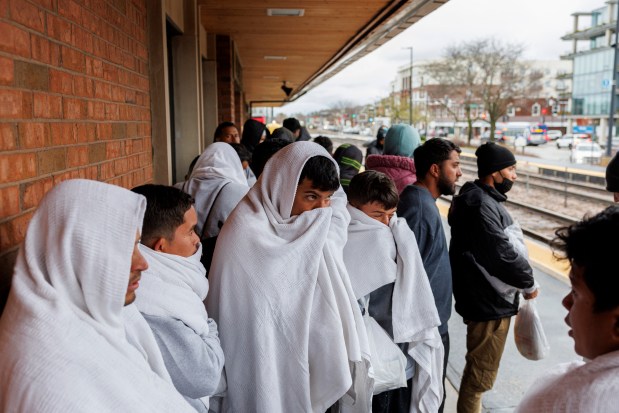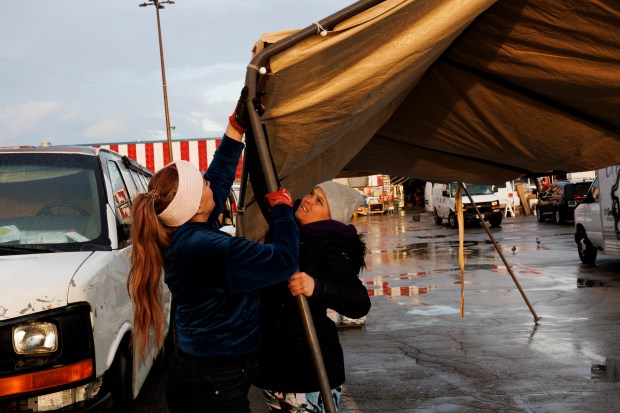As campaigns for the upcoming presidential election in November begin to sharpen their positions on immigration, a new study published Thursday reveals that anti-immigrant speeches sway voters purely based on rhetoric and not lived experiences.
Researchers from the UCLA Latino Policy and Politics Institute asked participants in the 2016 and 2020 elections about their attitudes on immigration and trade, which were then compared with their actual exposure to those variables. What they found was that former President Donald Trump’s anti-immigrant rhetoric resonates with many of his core supporters and also new voters — highlighting deep divides caused by race and national identity.
Researchers analyzed data from the U.S. Census Bureau’s American Community Survey and the Cooperative Election Study, a nationally representative sample of over 60,000 respondents. The data set includes information on voters’ partisanship, education, gender, age, income and employment status — and provides details for all 360 congressional districts.
Voters were asked in 2016 whether the U.S. government should deport undocumented immigrants and in 2020 whether it should build the border wall. For trade, voters were asked if they supported the Trans-Pacific Partnership, a multicountry trade agreement.
Raúl Hinojosa-Ojeda, a professor at UCLA and author of the study, said the more interaction communities had with immigrants and trade, the better their attitudes were toward them. The less interaction with immigrants, he said, the more negative. In his book, which tracks and analyzes election data since 2016, he has dubbed the phenomenon “The Trump Paradox.”
“(Trump) talks about immigration as if it’s destroying communities and his base,” Hinojosa-Ojeda said. “When in fact that’s patently not true. They cannot be destroying them because they’re not there.”
The results indicate that the Trump paradox is strongest among white men, not women. Latino voters, an important voting bloc for Democratic presidential nominee Vice President Kamala Harris, did not align with the paradox, though the study revealed a more nuanced voting pattern.
Trump won 35% of Latino voters in 2020, according to AP VoteCast. More Latinas who voted for Trump in that election were new voters compared with other gender, racial and ethnic groups, according to the study. They had lower average educational levels, the study found.
Hinojosa-Ojeda said these Latina voters were often younger, relying less on newspapers for news and more on social media like TikTok. They were low-propensity voters, or people who don’t vote regularly.
Soledad Álvarez Velasco, a social anthropologist and human geographer at the University of Illinois Chicago, attributed the pattern among these voters to Spanish philosopher Adela Cortina’s theory of “aporophobia,” the sometimes harsh treatment of immigrants and displaced people to a fear of poor or disadvantaged people. In 1995, Cortina asked herself why Spain was an open border country for tourists but not immigrants. She coined the term to describe a general widespread rejection of and aversion to the poor.
Velasco said young Latinas voting for Trump might see images online of impoverished people crossing borders and fear they might find themselves in the same situations, begging for money with a child or walking around looking for a home.
“There’s something they don’t like about the idea of (migrants) arriving to their same spaces,” Velasco said.
But Hinojosa-Ojeda said Harris is gaining momentum on social media, which could help her rating among these voters.
“TikTok is now all of a sudden flipping from being pro-Trump to pro-Kamala,” he said. “So there is an indication that support from those types of voters will not materialize for Trump this year.”
Ultimately, Hinojosa-Ojeda predicts hateful rhetoric will not favor the former president in 2024 due to both trends: changing social media trends coupled with diverse districts trending away from anti-immigrant and anti-trade sentiment.
He said 20 swing districts that voted for Trump in 2016 turned away from him in 2020. These districts are typically suburban, mixed districts with large immigrant populations, he said.
Last week, Harris made her first expansive pitch on immigration at a campaign rally in Arizona, where she promoted a border security bill that a bipartisan group of senators negotiated earlier this year. Republican lawmakers ultimately opposed en masse at Republican nominee Donald Trump’s behest.

If elected, Trump has promised sweeping deportations. He has vowed to round up immigrants, hold them in massive camps and put them on deportation flights.
Hinojosa-Ojeda said the potential effect of mass deportations would be the biggest economic crisis in the history of the U.S. — a hit of over $2 trillion.
Pooja Ravindran, the chief of staff for the city of Chicago’s Committee on Immigrant and Refugee Rights, said many undocumented immigrants pay taxes but can never access public benefits like Social Security.
“Both Republicans and Democrats are reliant on undocumented immigrants not only to bring in these taxes but work in low-wage, often dangerous jobs that U.S.-born workers will not,” Ravindran said.
Hinojosa-Ojeda grew up in Chicago and has fought for immigrant rights in the city for 40 years. He said Chicago, a welcoming city, provides one of the best examples of how immigrants benefit the economy.
The Associated Press contributed.





